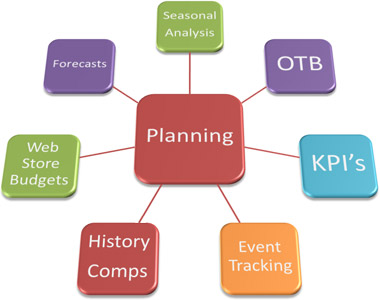Every ecommerce retailer understands the challenge of balancing overstocking and running out of inventory. Managing this balance is one of the most difficult parts of running an online store. That’s where strategic Ecommerce planning with Open-to-Buy (OTB) comes in. It helps retailers maintain control by ensuring the right products are available at the right time without tying up excessive cash.
According to the National Retail Federation (NRF), retailers that actively use structured planning tools and demand forecasting experience fewer markdowns and stronger margins. The message is clear: thoughtful inventory planning isn’t a nice-to-have—it’s a profit multiplier.
Let’s explore deeper into how OTB works, why it’s crucial for ecommerce businesses, and how EcomDrive’s Ecommerce planning module helps online retailers plan smarter, sell faster, and grow stronger.
What is Open-to-Buy for Retailers and Ecommerce Merchants?
Open-to-Buy (OTB) is a financial and inventory management tool that helps businesses determine how much stock to purchase for upcoming sales periods. It acts like a flexible budget designed to maintain the perfect balance between stock levels and sales forecasts.
In simple terms, it’s your buying plan—showing how much you can invest in inventory without overspending or missing out on demand. For ecommerce retailers, OTB ensures every purchasing decision aligns with revenue goals, seasonality, and marketing campaigns.
By keeping a close eye on OTB, retailers make informed choices—reducing overstock, cutting waste, and improving cash flow.
Why Open-to-Buy is Important for Your Business
Open-to-Buy is a critical component of ecommerce planning because it helps businesses:
- Align inventory with sales forecasts – It prevents stockouts while keeping excess inventory low.
- Improve cash flow management – It keeps cash flow healthy and predictable. Purchase only what’s needed, freeing up resources for other strategic initiatives.
- Boost profitability – It reduces markdowns and clearance sales by maintaining optimal stock levels.
- Support strategic growth – It makes informed decisions on product launches, seasonal items, and promotions.
How to Plan Open-to-Buy for Smarter Ecommerce Inventory Control
A well-structured OTB plan starts with your sales forecast. Once you estimate how much you’ll sell, you can calculate how much inventory you need to support those sales while maintaining healthy stock levels.
Steps for effective OTB planning:
- Review historical data: Analyze past sales trends, seasonality, and performance by category or product line.
- Set sales goals: Define realistic targets based on upcoming marketing campaigns and product launches.
- Estimate inventory needs: Determine the optimal stock required to meet those goals.
- Calculate OTB: Use the OTB formula to find out how much you can buy.
- Adjust regularly: Update your plan monthly or quarterly to reflect real-time performance.
By following these steps and leveraging Ecommerce planning tools, businesses can avoid understocking or overstocking, keeping inventory aligned with demand.
Top Benefits of Using Software to Simplify Open-to-Buy Planning
While spreadsheets can handle basic OTB planning, they quickly become complex as your ecommerce business scales. That’s where a modern Ecommerce planning system like EcomDrive makes the difference.
Key benefits:
- Real-time data analysis – Make quick, informed decisions based on up-to-date information.
- Automated calculations – Reduce manual errors and save time.
- Integrated systems – Maintain consistency across inventory, sales, and financial data.
- Enhanced visibility – Track KPIs, seasonality trends, and historical performance.
Retail planning software gives retailers agility—the ability to respond fast to shifts in consumer behavior, market trends, or supply chain delays.
Open-to-Buy Formula: Optimize Ecommerce Inventory and Cash Flow
Here’s the basic formula used by both retailers and ecommerce brands:
OTB = Planned Sales + Planned End-of-Month Inventory – Planned Beginning-of-Month Inventory
This calculation helps you identify how much inventory you can purchase for each period while maintaining your budget and stock goals. It’s simple but powerful, especially when automated by Ecommerce planning software like EcomDrive.
Best Practices for Effective Ecommerce Planning with Open-to-Buy
To get the most out of your OTB strategy, consistency and collaboration are key.
To maximize the effectiveness of OTB:
- Update forecasts regularly: Reflect market changes and evolving consumer behavior.
- Collaborate across departments: Align purchasing, sales, and finance for unified planning.
- Leverage historical data: Use past performance to guide future buying decisions.
- Monitor KPIs and benchmarks: Track sell-through, margins, and budget utilization to fine-tune strategies.
Strong OTB planning isn’t just about numbers—it’s about creating a culture of continuous optimization across your ecommerce organization.
How EcomDrive Supports Ecommerce Planning and Open-to-Buy Management
EcomDrive takes the complexity out of Ecommerce planning by integrating all essential OTB components into a single, easy-to-use system. Retailers gain real-time visibility into budgets, sales, and forecasts, allowing for smarter, faster decisions.
EcomDrive’s Ecommerce Planning Module includes:

- Open-to-Buy – Facilitates detailed inventory planning and control.
- Seasonality Analysis – Identifies trends to adjust stock levels.
- Forecasts – EcomDrive provides data-driven sales predictions.
- Web Store Budgets – Allocates resources effectively across online channels.
- KPIs – EcomDrive tracks key metrics to measure performance.
- Event Annotation – Marks events that may impact sales.
- Historical Comparisons – Guides future strategies based on past performance.
- Benchmark Monitoring – Compares results against industry standards.
By leveraging EcomDrive ecommerce software, retailers can streamline inventory management, optimize cash flow, and maximize profits with minimal manual effort. This integrated approach ensures that every buying decision is informed, data-backed, and profitable.
Plan Smarter with EcomDrive
The right Ecommerce planning system doesn’t just balance inventory—it builds a foundation for growth. By combining Open-to-Buy insights with advanced forecasting and analytics, EcomDrive helps ecommerce businesses optimize inventory, strengthen cash flow, and boost margins.
Ready to optimize your inventory and boost profits? Request a demo of EcomDrive today!

